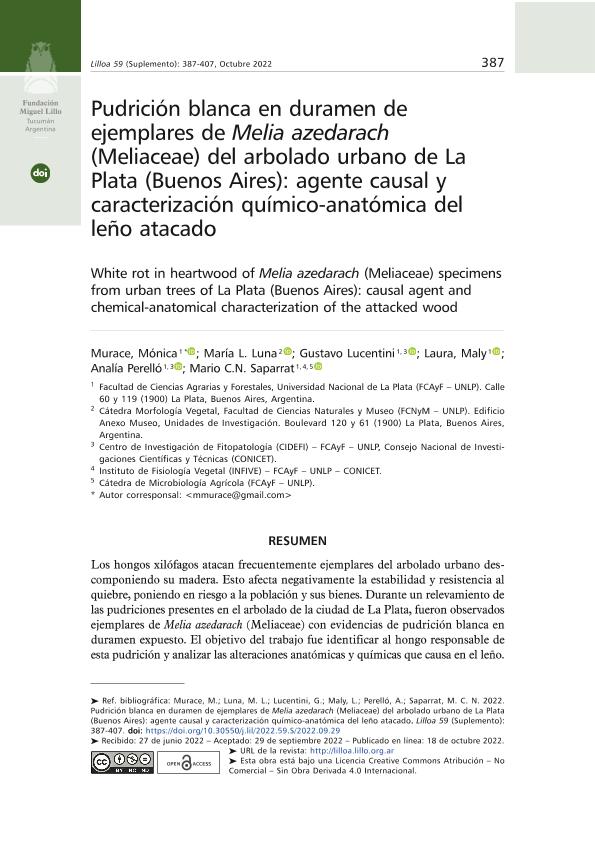Mostrar el registro sencillo del ítem
dc.contributor.author
Murace, Mónica Adriana

dc.contributor.author
Luna, María Luján

dc.contributor.author
Lucentini, Cesar Gustavo

dc.contributor.author
Maly, Laura Elizabeth

dc.contributor.author
Perello, Analia Edith

dc.contributor.author
Saparrat, Mario Carlos Nazareno

dc.date.available
2023-09-29T13:23:21Z
dc.date.issued
2022-10
dc.identifier.citation
Murace, Mónica Adriana; Luna, María Luján; Lucentini, Cesar Gustavo; Maly, Laura Elizabeth; Perello, Analia Edith; et al.; Pudrición blanca en duramen de ejemplares de Melia azedarach (Meliaceae) del arbolado urbano de La Plata (Buenos Aires): agente causal y caracterización químico-anatómica del leño atacado; Fundacion Miguel Lillo; Lilloa; 59; 10-2022; 387-407
dc.identifier.issn
0075-9481
dc.identifier.uri
http://hdl.handle.net/11336/213569
dc.description.abstract
Los hongos xilófagos atacan frecuentemente ejemplares del arbolado urbano descomponiendo su madera. Esto afecta negativamente la estabilidad y resistencia al quiebre, poniendo en riesgo a la población y sus bienes. Durante un relevamiento de las pudriciones presentes en el arbolado de la ciudad de La Plata, fueron observados ejemplares de Melia azedarach (Meliaceae) con evidencias de pudrición blanca en duramen expuesto. El objetivo del trabajo fue identificar al hongo responsable de esta pudrición y analizar las alteraciones anatómicas y químicas que causa en el leño. Se examinaron muestras de duramen con evidencias de pudrición blanca en estadios intermedio y avanzado extraídas de fuste y rama, respectivamente. Los aislamientos fúngicos fueron obtenidos de secciones de madera sembradas en agar malta con antibiótico y fungicida. La identificación fue llevada a cabo a partir de las características de las colonias y confirmada mediante técnicas moleculares. Los estudios anatómicos fueron realizados con microscopios estereoscópico, óptico y electrónico de barrido, y los análisis químicos mediante química húmeda y espectroscopía infrarroja transformada de Fourier (FT-IR). Phlebia brevispora (Basidiomycota, Polyporales) fue la única especie xilófaga aislada del material. Las alteraciones anatómicas registradas permitieron diagnosticar pudrición blanca simultánea en fuste y coexistencia de pudrición blanca simultánea y selectiva en rama. Mediante química húmeda fueron determinados incrementos relativos en el tenor de lignina y extraíbles lipofílicos, y disminuciones en el porcentaje de los extraíbles hidrofílicos en las muestras de ambos estadios de degradación (rama y fuste); la disminución del tenor de celulosa sólo fue identificada en rama. El FT-IR reveló el ataque a la celulosa y la lignina. Si bien existe información previa de la presencia P. brevispora en árboles en pie, el presente hallazgo constituye el primer registro para la Argentina, mientras que la interacción P. brevispora - Melia azedarach es reportada por primera vez en esta contribución.
dc.description.abstract
The xylophagous fungi frequently attack specimens of urban trees, decomposing their wood. This negatively affects stability and resistance to breakdown, putting the population and their goods at risk. During a survey of the rot present in the trees of La Plata city, specimens of Melia azedarach (Meliaceae) with evidence of white rot in exposed heartwood were observed. The aim of this work was to identify the fungus responsible for this rot and to analyze the anatomical and chemical alterations it causes in the wood. Heartwood samples with evidence of white rot in intermediate and advanced stages attained from stem and branch, respectively, were used. Fungal isolates were obtained from wood sections cultured on malt agar with antibiotic and fungicide. The identification was based on the characteristics of the colonies and confirmed by molecular techniques. Anatomical studies were performed with stereoscopic, optical and scanning electron microscopes and the chemical analysis by using wet chemistry and Fourier transform infrared spectroscopy (FT-IR). Phlebia brevispora (Basidiomycota, Polyporales) was the only xylophagous species isolated from the material. The anatomical alterations recorded allowed the diagnosis of simultaneous white rot in the stem and the coexistence of simultaneous and selective white rot in branch. Through wet chemistry, relative increases in the content of lignin and lipophilic extracts were determined, and decreases in the percentage of hydrophilic extractables in the samples of both degradation stages (branch and stem); the decrease in cellulose content was only identified in branch. FT-IR revealed the attack on cellulose and lignin. Although there is previous information about the presence of P. brevispora in standing trees, the current finding constitutes the first record for Argentina, while the interaction P. brevispora – Melia azedarach is reported for the first time in this contribution.
dc.format
application/pdf
dc.language.iso
spa
dc.publisher
Fundacion Miguel Lillo
dc.rights
info:eu-repo/semantics/openAccess
dc.rights.uri
https://creativecommons.org/licenses/by-nc-nd/2.5/ar/
dc.subject
ANATOMICAL MODIFICATIONS
dc.subject
CHEMICAL MODIFICATIONS
dc.subject
CHINA BERRY
dc.subject
PHLEBIA BREVISPORA
dc.subject
WOOD
dc.subject.classification
Micología

dc.subject.classification
Ciencias Biológicas

dc.subject.classification
CIENCIAS NATURALES Y EXACTAS

dc.title
Pudrición blanca en duramen de ejemplares de Melia azedarach (Meliaceae) del arbolado urbano de La Plata (Buenos Aires): agente causal y caracterización químico-anatómica del leño atacado
dc.title
White rot in heartwood of Melia azedarach (Meliaceae) specimens from urban trees of La Plata (Buenos Aires): causal agent and chemical-anatomical characterization of the attacked wood
dc.type
info:eu-repo/semantics/article
dc.type
info:ar-repo/semantics/artículo
dc.type
info:eu-repo/semantics/publishedVersion
dc.date.updated
2023-07-07T21:36:57Z
dc.identifier.eissn
2346-9641
dc.journal.volume
59
dc.journal.pagination
387-407
dc.journal.pais
Argentina

dc.description.fil
Fil: Murace, Mónica Adriana. Universidad Nacional de La Plata. Facultad de Ciencias Agrarias y Forestales; Argentina
dc.description.fil
Fil: Luna, María Luján. Universidad Nacional de La Plata. Facultad de Ciencias Naturales y Museo; Argentina
dc.description.fil
Fil: Lucentini, Cesar Gustavo. Universidad Nacional de La Plata. Facultad de Ciencias Agrarias y Forestales; Argentina. Consejo Nacional de Investigaciones Científicas y Técnicas. Centro Científico Tecnológico Conicet - La Plata; Argentina
dc.description.fil
Fil: Maly, Laura Elizabeth. Universidad Nacional de La Plata. Facultad de Ciencias Agrarias y Forestales; Argentina
dc.description.fil
Fil: Perello, Analia Edith. Universidad Nacional de La Plata. Facultad de Ciencias Agrarias y Forestales; Argentina. Consejo Nacional de Investigaciones Científicas y Técnicas. Centro Científico Tecnológico Conicet - La Plata; Argentina
dc.description.fil
Fil: Saparrat, Mario Carlos Nazareno. Universidad Nacional de La Plata; Argentina. Consejo Nacional de Investigaciones Científicas y Técnicas. Centro Científico Tecnológico Conicet - La Plata; Argentina. Universidad Nacional de La Plata. Facultad de Ciencias Agrarias y Forestales; Argentina
dc.journal.title
Lilloa
dc.relation.alternativeid
info:eu-repo/semantics/altIdentifier/doi/http://dx.doi.org/10.30550/j.lil/2022.59.S/2022.09.29
dc.relation.alternativeid
info:eu-repo/semantics/altIdentifier/url/https://www.lillo.org.ar/journals/index.php/lilloa/article/view/1635
Archivos asociados
